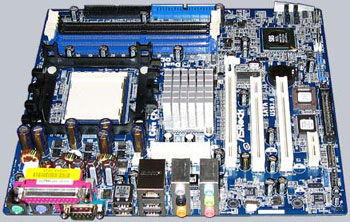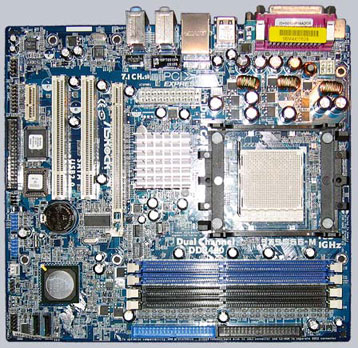
Result and general impression
+++ The ASRock 939S56-M motherboard has at present a price of approx. 54 Euro (12/2005) and is thus clearly below the so far tested Socket 939 PCIe motherboards. It is really amazing that ASRock creates again and again boards with such low prices, despite high-quality components e.g. the long-living capacitors and well-known ICs, etc. Surely because of the MicroATX format there’re a few features less on this motherboard, but nevertheless some interesting equipment characteristics remains.
Let us begin with the features, which this 244×224 mm small MicroATX motherboard offers. The board offers 2x IDE connectors for up to four ATA 133 hard disks, 2x SATA connectors which can also operate in RAID 0/1 mode, 4x ATX panel USB 2.0 ports, onBoard 10/100 LAN and 6 connectors for the RealTek ALC-850 7.1 Surround sound. There’re no digital input or output connectors, so there’s only the basic analog way to connect speakers to the onBoard sound card.
BTW beside Windows XP also older operating systems like e.g. Windows 98SE are supported, which is unfortunately no longer natural with PCIe boards. Who still would like to use older dual boot installations with the Win98SE, can find all necessary drivers on ASRock
as Download for the SiS chipset.
Furthermore the Motherboard can be equipped altogether with 4 DDR memory modules and is thus expandable to maximally 4 GB memory. The allocation for DUAL Channel support is specified in the manual and should be absolutely kept.
The BIOS can be achieved SiS like not as usual with the Del key, but with the F2 key. There’re extensive settings e.g. adjustments of the memory frequency of 133 MHz over 166 MHz up to 200 MHz, also the host clock between 140 and 300 MHz and the HT (hypertransport) frequency setting from 1x to 5x (200/800/1000 MHz) beside extensive memory timing. Unfortunately the change of the voltages comes somewhat too briefly, since only the memory voltage and the voltage of the CPU can be changed, but these two voltages are the most important ones for good overclocking results. The BIOS option “CPU overheat shutdown” should be absolutely used also without overclocking, since the feature can protect the CPU with a failed cooler against further damage. Furthermore one finds in the BIOS beside the CPU temperature also all informative monitoring of values e.g. chipset temperature, fan speed and all voltage levels.
Result: The inexpensive ASRock 939S56-M Socket 939 PCIe motherboard offers the most important features, which are necessary for the entrance into the fast 16x PCI express technology, whereby the performance of the SiS 756 chipset isn’t noticeably slower in combination with the SiS 965L South Bridge, as the up-to-date nVidia nForce4 motherboards. Owing to the 6 connectors for 7.1 sound, 2 x S-ATA ports, 10/100 LAN and up to 4 DDR-memory modules, which can operate in DUAL Channel mode, this board is quite recommended for inexpensive AMD Socket 939 gaming PCs. In addition, the overclocking doesn’t come too briefly, because almost all important settings are adjustable in the BIOS and thus helps to a faster PC for free.
Special thanks to ASRock
for their support.
**** All Socket 939 motherboard reviews since 01.11.2005 are based on an AMD Athlon 64 3000+ Venice processor, 1x (or SLI systems with 2x) Gigabyte GV-NX66T128VP Nvidia 6600 GT PCI Express video cards and the following software configuration: Microsoft Windows XP SP2, DirectX 9.0c, Forceware 81.85 video driver and 3DMark 2003. All benchmark results should only offer a comparison among themselves for a comparison.



